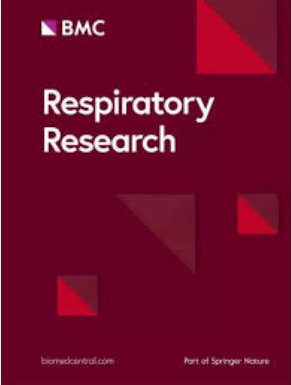Assessing the acceptability and feasibility of remote spirometric monitoring for rural patients with interstitial lung disease: a multimethod approach
IF 4.7
2区 医学
Q1 RESPIRATORY SYSTEM
引用次数: 0
Abstract
Interstitial lung disease encompasses a group of rare lung conditions causing inflammation and scarring of lung tissue. The typical method of monitoring disease activity is through pulmonary function tests performed in a hospital setting. However, accessing care can be difficult for rural patients due to numerous barriers. This study assesses the feasibility and acceptability of home spirometry telemonitoring using MIR-Spirometers and the patientMpower home-monitoring platform for rural patients with interstitial lung disease. Unblinded, uncontrolled, prospective, multiple-methods study of the feasibility and utility of remote monitoring of 20 rural subjects with interstitial lung disease. Study assessments include adherence to twice weekly spirometry for 3 months in addition to mMRC dyspnea and EQ-5D-5L health-related quality of life questionnaires with each spirometry maneuver. Upon completion, subjects were encouraged to complete an 11-question satisfaction survey and participate in semi-structured qualitative interviews to further explore expectations and perceptions of rural patients to telehealth and remote patient monitoring. 19 subjects completed the 3-month study period. Adherence to twice weekly spirometry was mean 53% ± 38%, with participants on average performing 2.26 ± 1.69 maneuvers per week. The median (Range) number of maneuvers per week was 2.0 (0.0, 7.0). The majority of participants responded favorably to the patient satisfaction survey questions. Themes regarding barriers to access included: lack of local specialty care, distance to center with expertise, and time, distance, and high cost associated with travel. Remote monitoring was well perceived amongst subjects as a way to improve access and overcome barriers. Remote spirometry monitoring through web-based telehealth is acceptable and feasible for rural patients. Perceived benefits include overcoming access barriers like time, distance, and travel costs. However, cost, reimbursement, and internet access must be addressed before implementing it widely. Future studies are needed to ensure long-term feasibility and to compare outcomes with usual care.评估农村间质性肺病患者远程肺活量监测的可接受性和可行性:一种多方法方法
间质性肺病是一组罕见的肺部疾病,会导致肺组织发炎和结疤。监测疾病活动的典型方法是在医院进行肺功能检查。然而,由于障碍重重,农村患者很难获得医疗服务。本研究评估了使用 MIR-Spirometers 和 patientMpower 家庭监测平台对农村间质性肺病患者进行家庭肺活量远程监测的可行性和可接受性。对 20 名农村间质性肺病患者进行远程监测的可行性和实用性的非盲法、非对照、前瞻性、多方法研究。研究评估包括坚持每周两次肺活量测定,为期 3 个月,以及每次肺活量测定时的 mMRC 呼吸困难和 EQ-5D-5L 健康相关生活质量问卷。研究完成后,我们鼓励受试者完成一份由 11 个问题组成的满意度调查,并参加半结构化定性访谈,以进一步了解农村患者对远程医疗和远程患者监护的期望和看法。19 名受试者完成了为期 3 个月的研究。每周两次肺活量测定的坚持率平均为 53% ± 38%,参与者平均每周进行 2.26 ± 1.69 次肺活量测定。每周操作次数的中位数(范围)为 2.0(0.0,7.0)。大多数参与者都对患者满意度调查问题做出了积极回应。与就医障碍相关的主题包括:当地缺乏专科医疗服务、距离具有专业知识的中心较远,以及与旅行相关的时间、距离和高昂费用。受试者普遍认为远程监测是改善就医条件和克服障碍的一种方法。对于农村患者来说,通过网络远程医疗进行远程肺活量监测是可以接受的,也是可行的。受试者认为其好处包括克服了时间、距离和差旅费等就医障碍。然而,在广泛实施之前,必须解决成本、报销和互联网接入等问题。今后还需要进行研究,以确保其长期可行性,并将结果与常规护理进行比较。
本文章由计算机程序翻译,如有差异,请以英文原文为准。
求助全文
约1分钟内获得全文
求助全文
来源期刊

Respiratory Research
医学-呼吸系统
自引率
1.70%
发文量
314
期刊介绍:
Respiratory Research publishes high-quality clinical and basic research, review and commentary articles on all aspects of respiratory medicine and related diseases.
As the leading fully open access journal in the field, Respiratory Research provides an essential resource for pulmonologists, allergists, immunologists and other physicians, researchers, healthcare workers and medical students with worldwide dissemination of articles resulting in high visibility and generating international discussion.
Topics of specific interest include asthma, chronic obstructive pulmonary disease, cystic fibrosis, genetics, infectious diseases, interstitial lung diseases, lung development, lung tumors, occupational and environmental factors, pulmonary circulation, pulmonary pharmacology and therapeutics, respiratory immunology, respiratory physiology, and sleep-related respiratory problems.
 求助内容:
求助内容: 应助结果提醒方式:
应助结果提醒方式:


